Fort Street Union Depot |
||
|---|---|---|
|
They came from the north, south, east and west, trains with names such as Ambassador, Cannon
Ball, Pere Marquette, Red Arrow, and Sportsman; their destination Detroit, Michigan -- more
specifically, Fort Street Union Depot (FSUD). Located near the heart of downtown, the
multi-story, dark red sandstone structure opened in early 1893. Newspaper accounts suggest
Pere Marquette predecessor Detroit Lansing & Northern on 22 January was the first railroad to
use the new terminal. Designed by Architects James Stewart & Company, the historic depot had
been a proud Detroit icon. One of four train stations which once served the city, the stately
81-year-old facility out-lived all of the others, including the first Michigan Central station.
(Michigan Central Railroad built the second MCS in 1913.)
During the immediate years following WWII, long-distance rail travel was still viewed as a viable and often a preferred means of travel. For example, the 1953 Official Guide showed nearly 30 trains a day arriving / departing Union Depot. Led by powerful diesels, trains bore the railroad names and colors of the Baltimore & Ohio, Chesapeake & Ohio (Pere Marquette), Pennsylvania and Wabash. These rail lines had been investing heavily in new locomotives and light-weight equipment in hopes of attracting the travelling public. However by 1970, the number and frequency of passenger trains had shrank appreciably owing to America's love affair with the family automobile and a growing preference for time-saving airline travel. The last train to depart FSUD was the Norfolk & Western / Wabash's St. Louis-bound Cannon Ball on 30 April 1971. 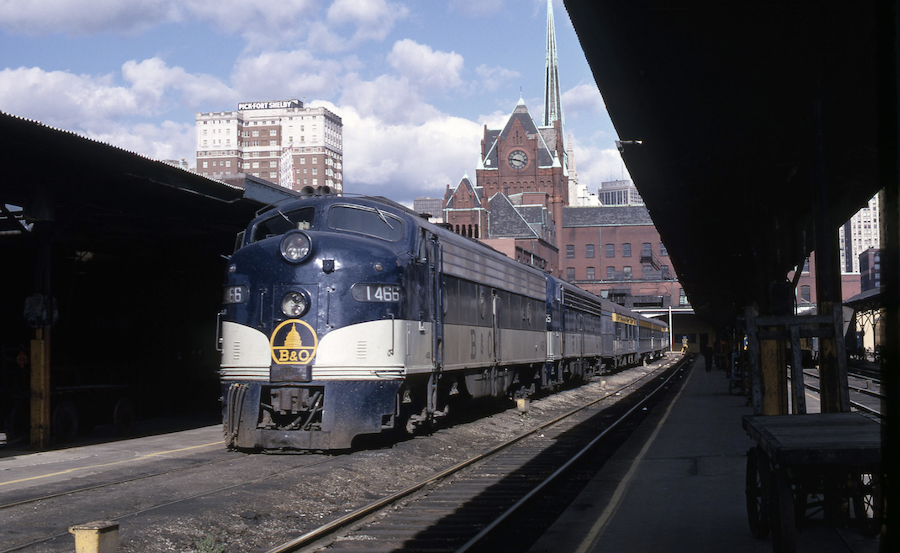 (Photo above:) On an October day in 1968, Harry Juday caught a pair of B&O E-units led by #1466 (ex-C&O #4012) waiting to take the afternoon "Captiol Limited" to Washington D.C. (Joe Ferguson collection) |
||
Stands in Silence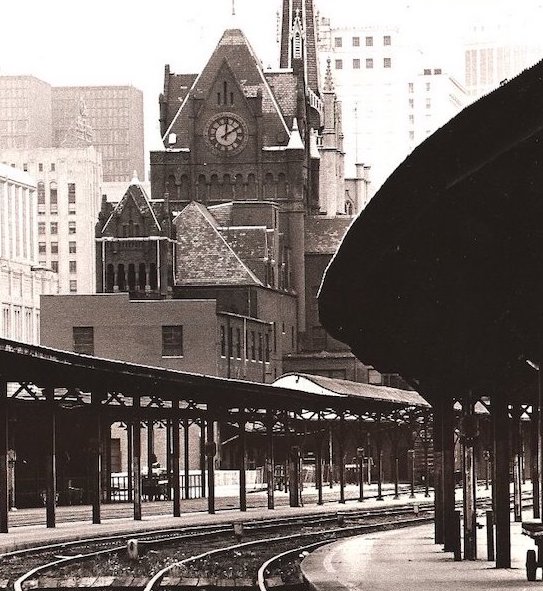 It is 2:00 pm straight-up and the only thing moving at FSUD are the hands on the clock; time has nearly run-out for the Romanesque-revival style station and its four-story clock tower. Attempts to re-purpose the historic building have failed, and demolition completion has been scheduled for late January of 1974, The station's unique clock face reads "IIII" rather than "IV." (Detroit Free Press Archives) Romance of Transportation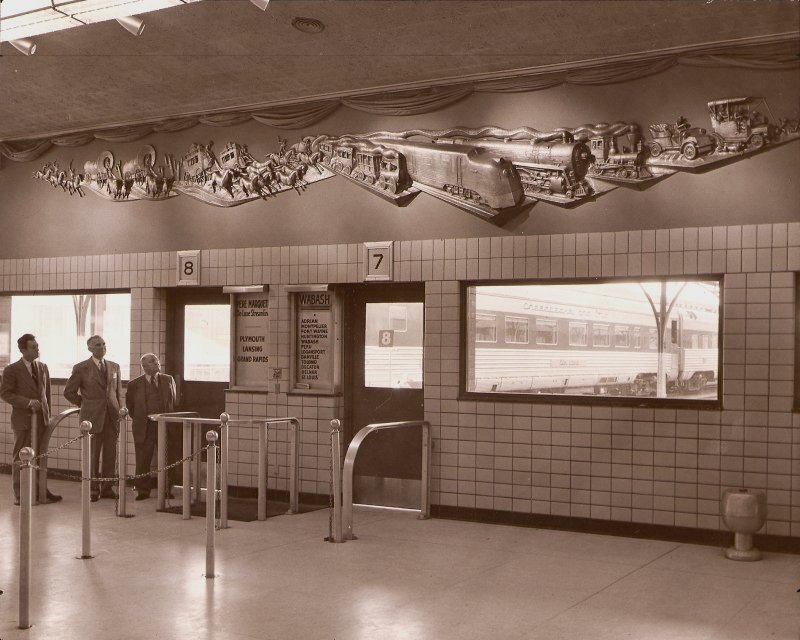 The station ownership in 1948 commissioned renowned artist and sculptor Marshall Fredericks to a create a signifiant mural for the depot. He responded by designing a large three-panel aluminum mural which was publicly unveiled in May 1951. Titled "Romance of Transportation" the 44-foot-long piece of art depicted the evolution of ground transportation travel from the horse and buggy era to the age of powerful diesel locomotives in colorful garb. With closure of the train terminal, the original sculpture was moved permanently to a new home at the B&O railroad museum located in Baltimore, Maryland. (Detroit Free Press Archives) | ||
Union Belt of Detroit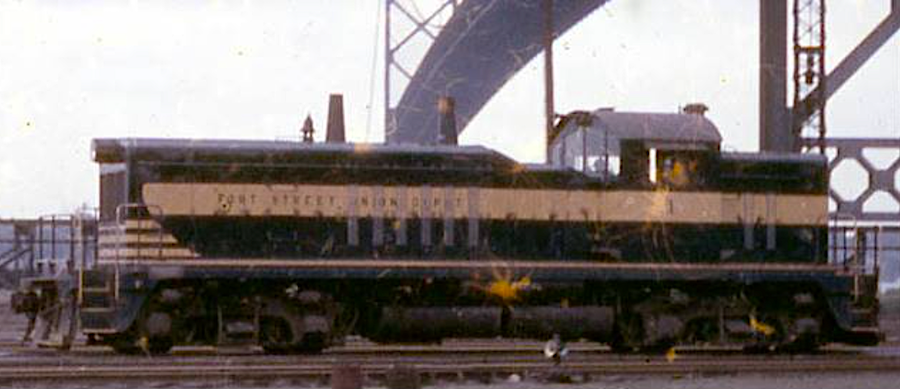 |
Pere Marquette Advertising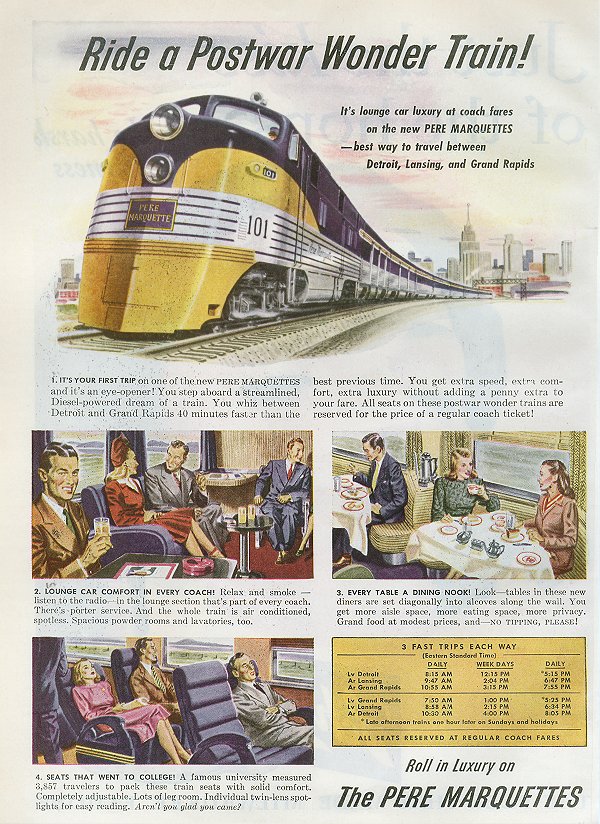 |
|
Pere Marquette / C&O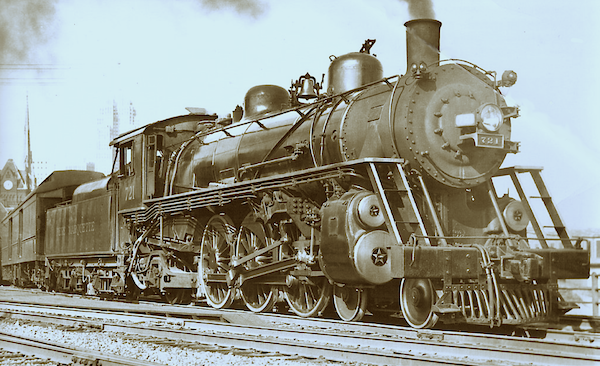 Equipped with 77-inch drivers the Pere Marquette 4-6-2 Pacific was an impressive-looking machine. Rated at 31,000 pounds of tractive effort, the class SP-3 #721 was typically entrusted with the railroad's flagship passanger trains, including No. 3 the westbound Sportsman seen in this 1926 photo at Union Depot. The 4-6-2 Pacific was built by Alco's Brooks Locomotive Works and steamed to life in 1921. Chesapeake & Ohio acquired the 2600-mile PM in 1947; the #721 remained on the active roster for an additional four years. (Photographer unknown) |
Chesapeake & Ohio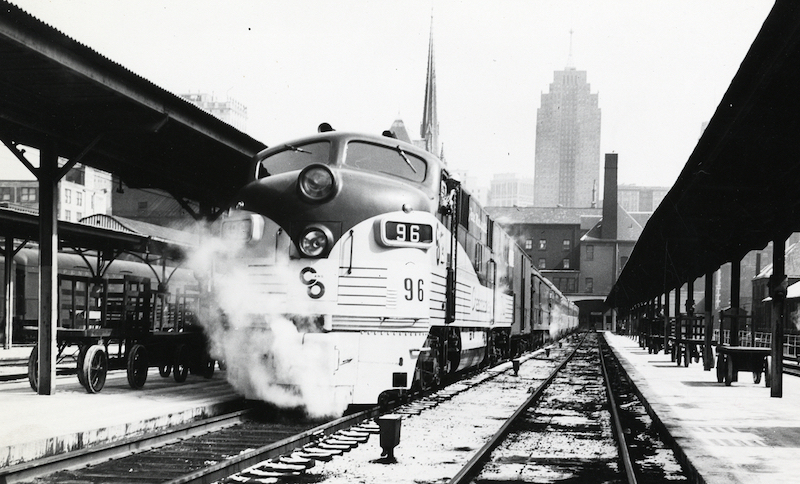 Purchased new by C&O in July 1948, EMD-built #96 was one of four E7As (#95-98) that were delivered wearing the same color scheme as the recently acquired Pere Marquette RR and its passenger train equipment. PM's rail operations had spanned Michigan, Ohio, Indiana and southern Canada. The newcomers could be easily distinguished from earlier PM E-units by their large angled number-boards. By 1965, this E-unit had been renumbered to 4521 and wore traditional C&O attire. (Burton Historical Collection / Detroit Public Library |
|
Chesapeake & Ohio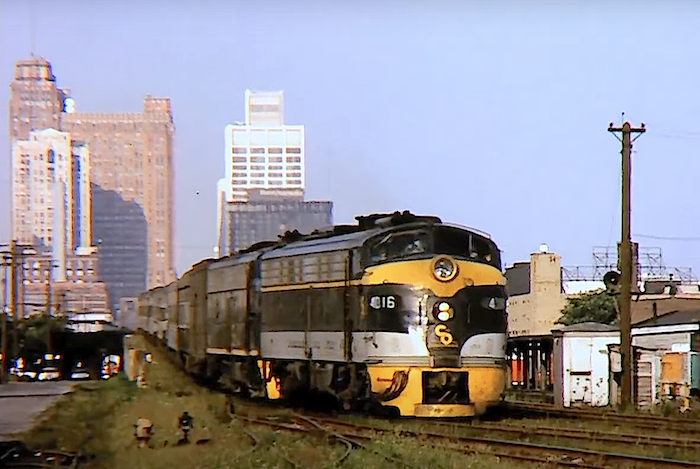 C&O Train #4/46, The Sportsman, has departed the historic FSUD at 5:40 pm as advertised. The #4016 and another six-axle companion descend the four-block-long trestle that leads away from the iconic terminal building (located at the northwest corner of Fort St. and Third Ave.) The two Es and their elongated consist are bound for Newport News, VA. (Emery Gulash photo / courtesy of Green Frog Productions) |
Baltimore & Ohio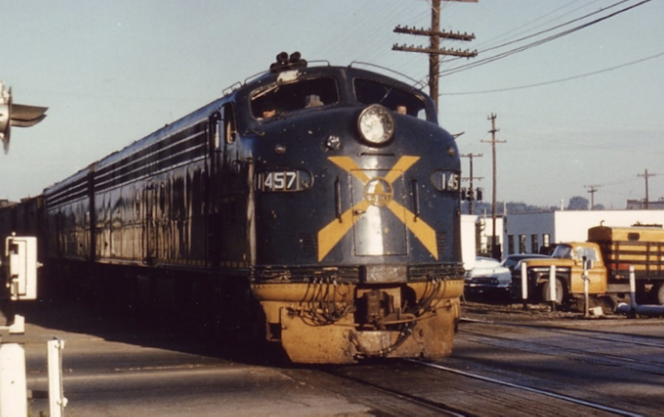 B&O passenger trains began using Union Depot during 1925; they relocated to Michigan Central Station soon after the close of World War II. A return to FSUD occurred in May 1964, but the timetable consisted only of Trains 53/54 (Ambassador) and 57/58 (Cincinnatian). This August 1964 view shows Train 58 minutes out of Detroit while enroute to the Queen City. (Bill Hakkarinen photo) |
|
Pennsylvania RR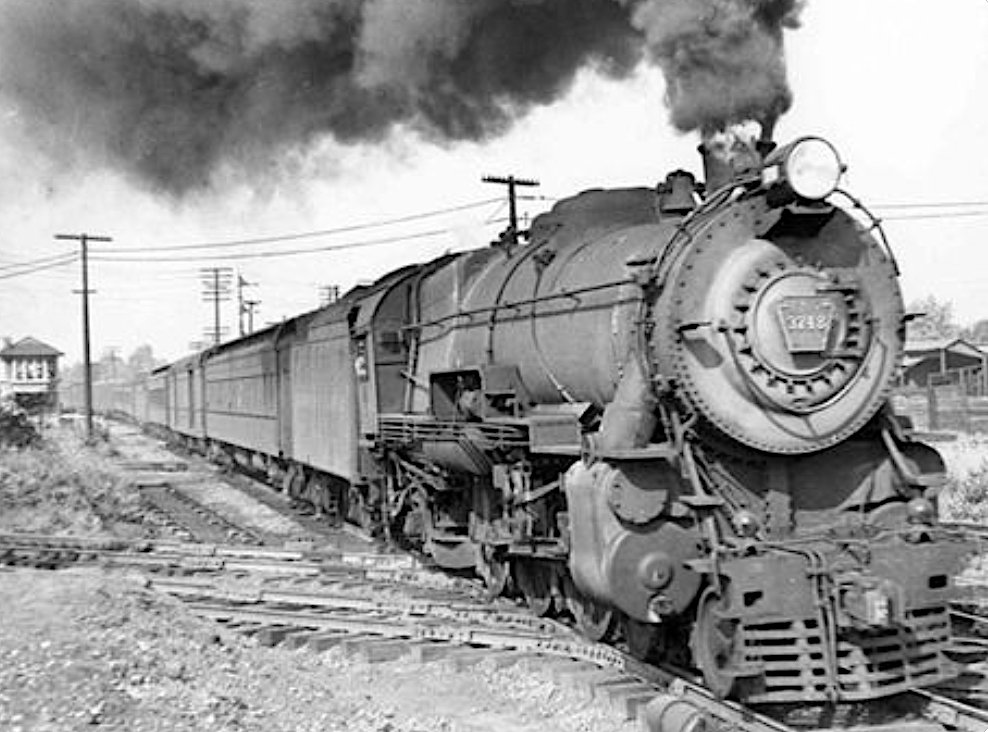 This Summer morning 1941 shot depicts PRR's "Red Arrow" (New York City-Detroit flagship) just minutes from a FSUD arrival; a 20-year-old K4 #3748 has the honor. As the 1950s drew to close patronage shrank significantly and the train was reduced to a Detroit-Toledo local. The Red Arrow exited the Fort Street Union station for the final time on 25 July 1959. (Charlie Whipp collection) |
Pennsylvania RR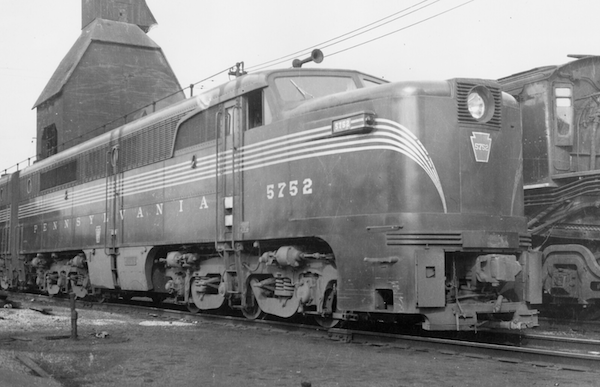 Of particular interest to Alco PA fans locally were the three railroads that routinely employed the Schenectady-builder's six-axle cab units in passenger service into Detroit; Pennsy was one of the rail lines (as was New York Central and Wabash). On an August day in 1958, Alco PA1 #5752 was being serviced at Wabash's Delray engine facility. Later in the day, the big Alco will lead the Arrow towards Toledo. (Photographer unknown / Craig Garver collection) |
|
Wabash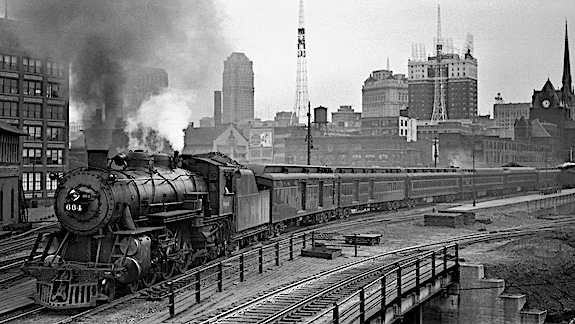 |
Wabash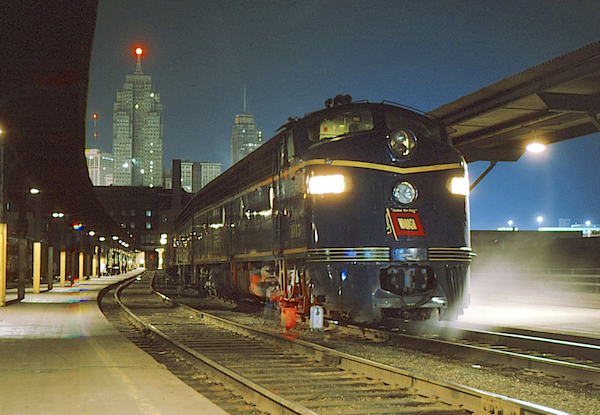 |
|
Wabash / Norfolk & Western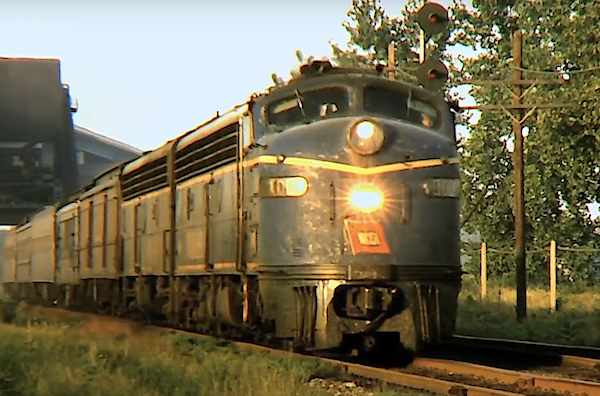 After the N&W's October 1964 take-over of the Wabash and Nickel Plate (along with two short lines), the predominantly southeastern coal hauler continued to operate the Cannon Ball right up to the last day. The newly formed Amtrak had no plans to incorporate the the 480-mile St. Louis-Detroit train route into its national rail network. The historic Cannonball departed Detroit for the very last time on 30 April 1971. ((Emery Gulash photo / courtesy of Green Frog Productions) |
Acknowledgements: | |
| New: 1 October 2023 | ||